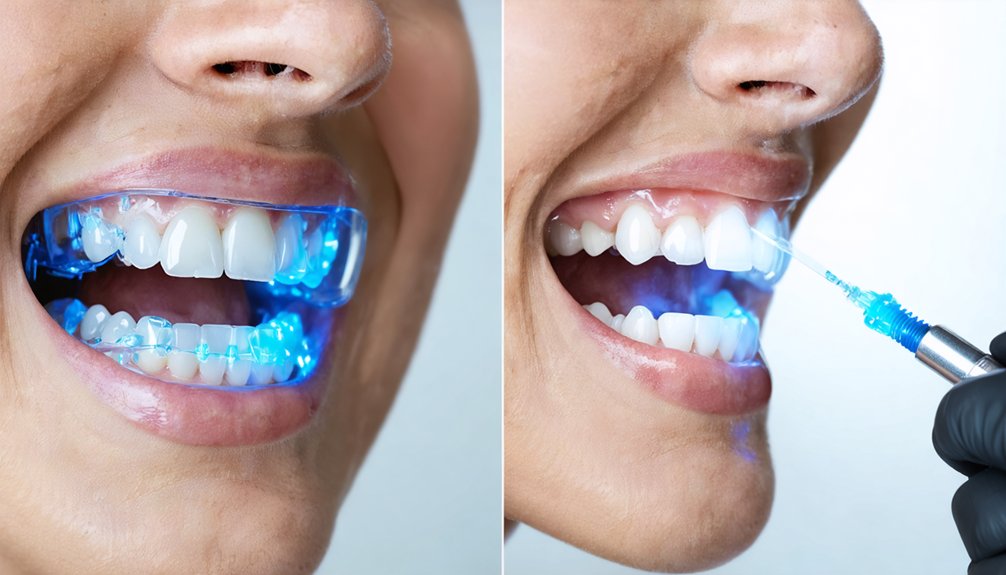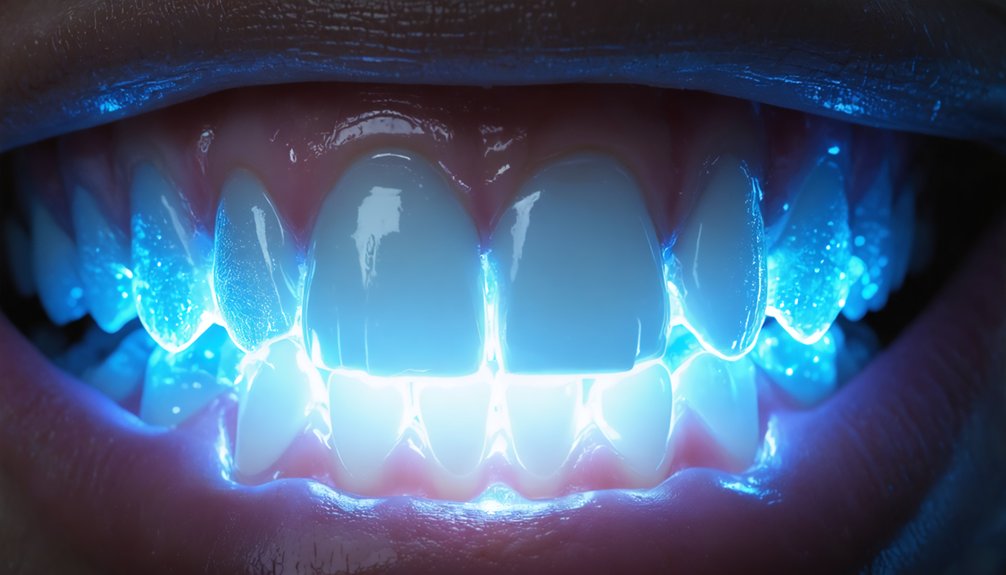Blue LED light, specifically in the 456-490 nanometer wavelength range, will dramatically speed up your teeth whitening results. It works by activating peroxide-based whitening gels, creating oxygen radicals that break down stains more effectively. You’ll see up to 50% faster results compared to non-light treatments, with professional LED systems achieving up to eight shades improvement in just 30-45 minutes. Understanding the science behind this technology reveals even more impressive benefits.
Key Takeaways
- Blue LED light at wavelengths around 456 nm effectively activates peroxide-based whitening gels for enhanced tooth whitening results.
- LED-assisted treatments achieve up to 30% faster whitening with noticeable results in 60 minutes using moderate concentration peroxide gels.
- Professional blue LED technology can achieve up to eight shades improvement in 30-45 minutes with proper gel application.
- Violet LED (405 nm) shows potential for teeth whitening but lacks extensive research compared to blue light technology.
- UV light is no longer recommended for teeth whitening due to safety concerns, while LED lights provide controlled activation with minimal heat.
Understanding Blue Light’s Role in Dental Whitening
While traditional teeth whitening relies solely on chemical agents, blue light technology has revolutionized the process by greatly enhancing the effectiveness of whitening treatments.
Operating at wavelengths around 456 nm, blue light acts as a powerful catalyst that accelerates oxidative reactions when combined with whitening gels.
When you undergo dental whitening with blue light, the technology targets stains in two distinct ways.
First, it activates hydrogen peroxide molecules, releasing oxygen radicals that chemically break down stains.
Second, it directly photobleaches chromophores, addressing discoloration that peroxide alone might miss.
The light safely penetrates your enamel without generating heat, making it an ideal companion to whitening agents.
This dual-action approach allows for lower concentration gels while achieving superior results, transforming your smile more efficiently than traditional methods. The SNOW LED mouthpiece provides a convenient at-home solution for achieving professional-grade whitening results. The innovative device features dentist-grade technology that delivers dramatic whitening results compared to strips alone.
The Science Behind Light-Accelerated Treatments
You’ll find that light-accelerated teeth whitening treatments rely on specific wavelengths, particularly in the blue spectrum, to catalyze peroxide breakdown and enhance stain oxidation.
While LED lights offer controlled activation with minimal heat production, other sources like diode lasers and halogen lamps can generate more heat and potentially increase tooth sensitivity. Modern LED devices ensure optimal results by providing blue wavelength light that accelerates oxidation without damaging teeth.
The ideal balance between treatment speed and safety depends on selecting appropriate light wavelengths that maximize peroxide activation while minimizing thermal stress to your dental tissues. Dental professionals use high-concentration peroxide alongside light activation to achieve faster, more dramatic whitening results.
Light Wavelength Analysis
Three primary light sources – LED, halogen, and diode laser – form the foundation of modern light-accelerated teeth whitening treatments.
The wavelength impact of blue light (460-490 nm) shows the strongest scientific backing, particularly when combined with peroxide-based gels. You’ll find that blue light’s light absorption properties make it especially effective at activating whitening agents. Minimal power consumption makes LED lights highly efficient for dental practices. Research indicates that light activation methods demonstrate varying levels of effectiveness in clinical settings.
While violet LED (405 nm) also demonstrates promise, particularly with carbamide peroxide, it hasn’t accumulated as much research support as blue light.
UV light, once common, is no longer recommended due to safety concerns. The debate continues about the ideal wavelength for maximum effectiveness, but blue spectrum consistently delivers the most reliable results in clinical studies.
When choosing a treatment, you’ll want to focus on options utilizing blue LED technology for the most predictable outcomes.
Safety vs. Speed Benefits
Although light-accelerated teeth whitening promises faster results, understanding the balance between speed and safety remains vital for ideal treatment outcomes.
You’ll find that LED-assisted treatments can achieve up to 30% faster whitening while maintaining a favorable safety profile when proper safety measures are followed.
The speed benefits are most apparent when combining moderate concentration peroxide gels with appropriate light wavelengths, delivering noticeable shade improvements in just 60 minutes.
However, you’ll need to take into account that overuse can lead to temporary enamel dehydration. Studies show that the violet LED wavelength specifically targets and breaks down pigmented molecules without significant dental structure interaction.
When administered correctly, these treatments typically show low sensitivity rates and minimal gum irritation.
The blue LED light technology safely accelerates the whitening process while offering variable intensity settings for sensitive patients.
To maximize both safety and effectiveness, it’s important to use the right combination of light intensity, exposure duration, and peroxide concentration while allowing adequate time for rehydration between sessions.
Safety Considerations for Light-Based Whitening
When using light-based teeth whitening treatments, you’ll need to monitor for signs of excessive heat exposure, including sharp pain, burning sensations, or prolonged sensitivity.
The peroxide-based gel must be carefully applied according to instructions before using any light treatment.
You should wear proper eye protection designed specifically for the wavelength of light being used during your whitening procedure.
To prevent tissue damage, guarantee the light source maintains the manufacturer’s recommended distance from your teeth and isn’t focused on any single area for too long.
Professional consultation is essential before starting any light-based whitening treatment to ensure safety and effectiveness.
Heat Exposure Warning Signs
Since light-based teeth whitening treatments generate heat to accelerate peroxide breakdown, you’ll need to watch for specific warning signs that indicate potential overexposure.
Look for sharp sensitivity when consuming hot, cold, or acidic items, as this suggests the heat has penetrated through your enamel to the dentin. Monitor your gums for redness, swelling, or soreness, which can signal chemical burns from heat-activated agents.
If you notice your teeth becoming translucent or unevenly whitened, stop treatment immediately, as this indicates structural enamel damage.
Pay attention to any lingering heat sensitivity that persists beyond several days after treatment, particularly if you’ve undergone multiple sessions.
Contact your dental professional if you experience prolonged discomfort or severe gum irritation, as these symptoms may require intervention.
Light Protection Guidelines
Safe light-based teeth whitening requires strict adherence to protective guidelines.
For ideal light safety, you’ll need to avoid UV light systems due to their potential for soft tissue damage and opt instead for blue LED treatments under professional supervision. Monitor treatment duration carefully and follow manufacturer specifications to prevent enamel weakening.
For effective sensitivity management, space out your whitening sessions appropriately and use fluoride-based products after treatment to help remineralize your enamel.
If you experience heightened tooth sensitivity, apply desensitizing toothpaste between sessions. You should be particularly cautious if you have dental restorations, as these can increase sensitivity risks.
Remember that light activation, while popular, hasn’t consistently shown significant benefits over traditional bleaching methods, so don’t exceed recommended exposure times.
Comparing Different Light Technologies
Modern teeth whitening technology employs various light-based systems to enhance the effectiveness of whitening agents.
LED systems offer significant advantages, boosting whitening effectiveness by up to 50% with minimal heat generation.
Laser precision enables targeted treatment of stubborn stains, delivering 6-8 shade improvements in a single session.
While halogen effectiveness matches that of LEDs and lasers in laboratory studies, its heat output requires careful monitoring.
UV risks outweigh potential benefits, making it less recommended despite its whitening capabilities.
For those concerned about sensitivity management, non-light alternatives provide gentler treatment options, though treatment duration may be longer.
When considering cost considerations, non-light systems typically offer more affordable solutions, while laser treatments command premium pricing due to their precision and rapid results.
Professional Vs At-Home Light Treatments

Two distinct approaches define light-activated teeth whitening: professional in-office treatments and at-home LED systems.
Professional treatments use high-concentration peroxide (25-35%) with specialized lights, delivering immediate results in a single session. However, they’re more likely to cause sensitivity, with 53% of patients reporting discomfort compared to non-light methods.
At-home effectiveness varies with LED kits using lower peroxide concentrations (10-15%). While these treatments offer greater convenience and affordability, you’ll need multiple applications over two weeks to achieve visible results.
Professional treatments provide more dramatic whitening but at a higher cost and sensitivity risk. At-home systems trade immediate impact for gentler, gradual improvement with less tooth sensitivity, making them suitable for mild whitening needs.
Latest Innovations in Light-Enhanced Whitening
Recent breakthroughs in light-enhanced teeth whitening have revolutionized both professional and at-home treatments.
AI integration now allows smart LED systems to adapt light intensity and duration based on your unique enamel sensitivity and tooth shade. These systems work synergistically with advanced whitening gels containing nanoparticles that simultaneously whiten and remineralize your teeth.
You’ll find cutting-edge innovations like custom 3D-printed trays that guarantee precise gel distribution and ideal light exposure.
The latest blue LED technology can help you achieve up to eight shades of improvement in a single 30-45 minute session, while generating less heat than traditional methods.
Mobile apps provide real-time monitoring and personalized treatment adjustments, assuring you get maximum results with minimal sensitivity.
Frequently Asked Questions
How Long Should I Wait Between Light-Accelerated Whitening Treatments?
Like a patient moon cycle, you’ll need 6-12 months between full treatment intervals. For touch-ups, wait at least 3 months. Follow your dentist’s specific whitening frequency recommendations.
Can Light-Accelerated Whitening Remove Deep Stains From Antibiotics or Fluorosis?
You’ll find light-accelerated whitening has limited success with antibiotic stains and fluorosis treatment. These deep, intrinsic discolorations often require alternative professional treatments for effective results.
Will Light Treatments Affect Existing Dental Work Like Crowns or Veneers?
You won’t see light treatment effects on crowns or veneers as they don’t whiten. Your dental work will stay the same color while natural teeth lighten, potentially creating noticeable color differences.
Does Eating Certain Foods Impact the Effectiveness of Light-Accelerated Whitening?
Yes, your food choices considerably affect whitening results. You’ll need to avoid staining foods and drinks for 24-48 hours after treatment to prevent re-staining and maintain ideal brightness.
Can Pregnant Women Safely Undergo Light-Accelerated Teeth Whitening Procedures?
Better safe than sorry – you shouldn’t undergo light-accelerated teeth whitening during pregnancy. Focus on safe alternatives like gentle brushing and avoiding staining foods until after delivery, following pregnancy precautions.
References
- https://pmc.ncbi.nlm.nih.gov/articles/PMC7881219/
- https://pmc.ncbi.nlm.nih.gov/articles/PMC4058574/
- https://www.nature.com/articles/s41407-022-0900-4
- https://www.clinicalresearchdental.com/blogs/whitening-hygiene/the-science-behind-teeth-whitening
- https://www.trysnow.com/blogs/news/blue-light-teeth-whitening
- https://crest.com/en-us/oral-care-tips/how-blue-light-teeth-whitening-works
- https://tryautobrush.com/blogs/dental/how-does-blue-led-light-teeth-whitening-work
- https://valleycreekdentalcare.com/blog/is-blue-light-teeth-whitening-safe-for-regular-use-heres-what-you-need-to-kno
- https://www.colgate.com.au/oral-health/teeth-whitening/how-does-led-teeth-whitening-work
- https://www.hardindental.com/blog/tooth-whitening-with-led-blue-light/



